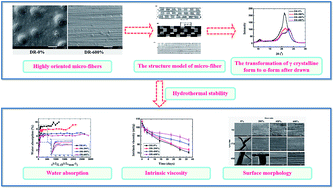Structure and hydrothermal stability of highly oriented polyamide 6 produced by solid hot stretching
Abstract
Highly oriented polyamide 6 (PA6) was successfully fabricated through solid hot stretching technology. The effect of orientation on the structure and hydrothermal stability of PA6 was investigated. It was found that molecular orientation reduced the hydrophilicity of PA6 and restricted the water uptake, and therefore hindered molecular hydrolytic degradation. The α crystalline form was mainly formed for the oriented PA6. With the increase of draw ratio, the crystallinity and orientation factor of PA6 increased, the fractional free volume (fv) decreased, and a dense crystalline structure was formed. During aging, the crystalline form of PA6 changed from γ to α, and thus compared with the isotropic sample, the oriented sample can retain a relatively stable dense crystalline structure, which was favorable for the inhibition of water diffusion into PA6 and slowing down the hydrolytic degradation. This investigation clearly showed that molecular orientation can be an efficient way to enhance the hydrothermal stability of PA6.


 Please wait while we load your content...
Please wait while we load your content...